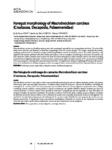Please use this identifier to cite or link to this item:
http://www.alice.cnptia.embrapa.br/alice/handle/doc/1045150| Title: | Foregut morphology of Macrobrachium carcinus (Crustacea, Decapoda, Palaemonidae). |
| Authors: | LIMA, J. de F.  GARCIA, J. da S.   TAVARES, M.   |
| Affiliation: | JO DE FARIAS LIMA, CPAF-AP; JAMILE DA SILVA GARCIA, UEAP, Macapá, AP; MARCOS TAVARES, USP, São Paulo, SP. |
| Date Issued: | 2016 |
| Citation: | Acta Amazonica, Manaus, v. 46, n. 2, p. 209-218, 2016. |
| Description: | Macrobrachium carcinus is a Brazilian native prawn with recognized potential for use in aquaculture activities. The aim of this study was to describe and illustrate in detail the morphology of the M. carcinus foregut. The foregut comprises the mouth, esophagus and stomach. It is lined by a simple cylindrical epithelium overlain by chitinous cuticle. The cardiac chamber is well supplied with muscles and lined with chitin thickened in places to form a complex, articulating set of ossicles. The ossicles and setae inside the cardiac chamber seem to direct the food movement through the cardiac chamber and sort the food according to particle size as digestion takes place. Twenty-one basic ossicles were observed in the stomach of M. carcinus and are divided into seven categories, reflecting their presumed functional roles. The significance of these morphological features is discussed in terms of its implication in feeding management that can support future commercial farms of this important fishery resource. |
| Thesagro: | Aparelho digestivo Aquicultura |
| NAL Thesaurus: | Aquaculture Digestive system |
| Keywords: | Estratégia alimentar Feeding management Freshwater prawn Pitu |
| Type of Material: | Artigo de periódico |
| Access: | openAccess |
| Appears in Collections: | Artigo em periódico indexado (CPAF-AP)  |
Files in This Item:
| File | Description | Size | Format | |
|---|---|---|---|---|
| CPAFAP2016Foregutmorphology.pdf | 863.56 kB | Adobe PDF |  View/Open |









